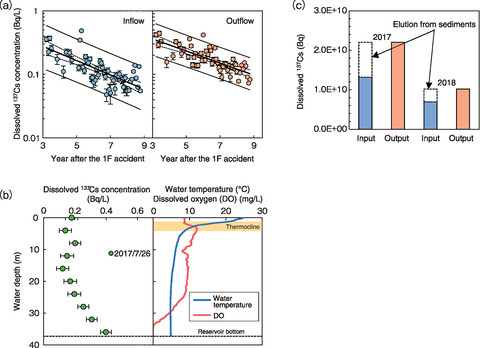
Fig.1-32 Dissolved 137Cs in reservoir
The origins and dynamics of dissolved radionuclides with high mobility and bioavailability in freshwater systems must be clarified to assess their transfer from water to crops and aquatic organisms. To quantitatively evaluate the long-term temporal changes and detail the mass balance of dissolved 137Cs in the Ogaki Dam Reservoir, which has a catchment with a high 137Cs inventory due to the accident at TEPCO's Fukushima Daiichi NPS (1F), we investigated 137Cs concentrations using time series of water input and output samples.
Our results showed that the dissolved 137Cs concentration was significantly higher in the output water than in the main input water, as shown in Fig.1-32(a). Additionally, the effective environmental half-life of 137Cs was longer in the output water (3.6 y) than in the input water (2.9 y). Thus, the concentration of dissolved 137Cs was influenced by the supply from the river input and production within the reservoir (e.g., elution from sediments). The vertical temperature profile showed a stratification with a clear thermocline; hypolimnetic anoxia occurred below a depth of 33 m, as shown in Fig.1-32(b). The dissolved 137Cs concentration was relatively constant under oxic conditions but increased with depth under anoxic conditions. These results support the assertion that the 137Cs concentration gradients in the reservoir water column were caused by the release of 137Cs from sediment to the overlying water. This mobilization of 137Cs from the sediment likely results from the ion-exchange displacement of 137Cs from sediments by cations (e.g., NH4+) released during the anaerobic decomposition of organic matter. We also performed a mass balance of dissolved 137Cs in the reservoir to elucidate the contribution of dissolved 137Cs from the river and reservoir sediments to 137Cs in the reservoir output. The annual output of dissolved 137Cs was significantly higher than the total dissolved 137Cs input; approximately 32%-40% of the dissolved 137Cs output was not input by the river and, thus, likely produced from sediments, as summarized in Fig.1-32(c).
Our results regarding the long-term dynamics and mass balance of dissolved 137Cs in the reservoir provide important quantitative information for evaluating the catchment's environmental recovery rate and the presence of reservoir sediments containing high 137Cs levels.
(Hironori Funaki)